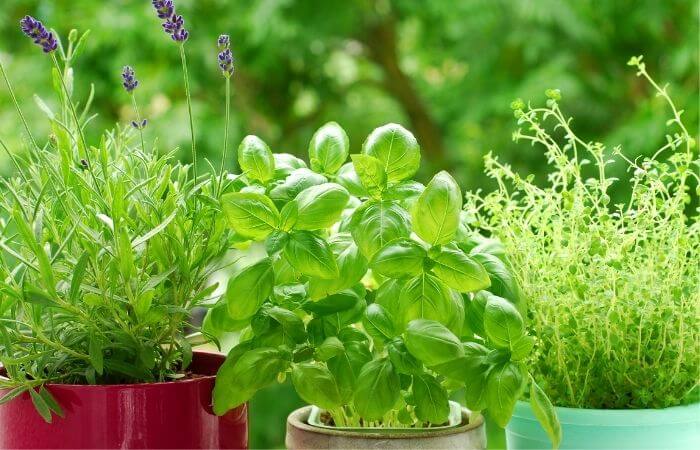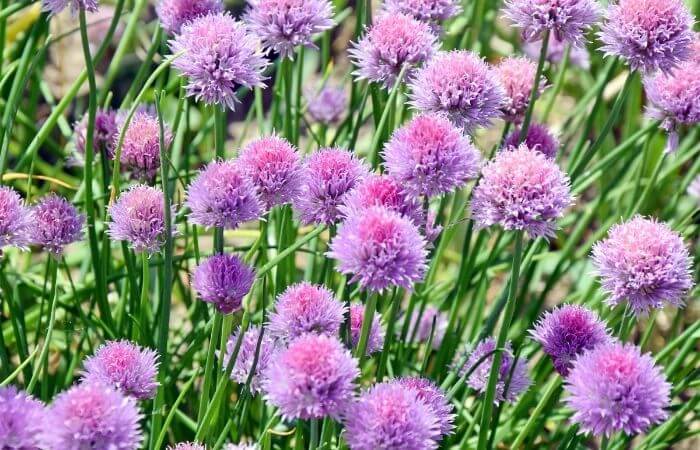Want to know the secret to have a bountiful herb garden?
When planting herbs together, the trick is knowing which herbs belong together. Not all herbs are on the same page when it comes to water, sunlight, soil, or nutrient needs, so mixing them can create serious problems and poor results.

To assist you, I put together this short guide to herbs that grow well together so you can avoid this common gardening mistake.
By the end, you’ll know which herbs grow best together and why, plus the ones to never plant together, so your next herb garden turns out to be a rousing success!
Herbs That Can Be Planted Together
Any of these herbs can mix in a planter or garden bed with exceptional results.
1. Chives & Every Herb

Chives can grow in harmony with every other herb. Better yet, chives attract pollinators while repelling aphids and other pests.
2. Rosemary, Thyme & Sage
Rosemary, thyme, and sage all share the same love of sunlight and drier soil, and all are perennials, so you won’t have to re-pot for several years.
3. Marjoram, Oregano, Thyme, & Lavender
Marjoram, oregano, thyme, and lavender are another grouping that fair well together as a group or in pairs.
4. Cilantro, Basil, Parlsey & Chervil
Annual herbs cilantro, basil, parsley, and chervil all thrive on moist soil and all-day sun, so grouping two or more of these together is a smart move when you want to streamline your gardening chores.
5. Arugula, Tarragon & Chamomile
Arugula, tarragon, and chamomile all prefer a pot that allows for deeper root growth. Enrich the soil with compost and add in some perlite for better drainage. Tarragon is a natural pest repellent, which will aid all the herbs around it.
Other Great Herb Pairs
Here are a few of my favorite herb pairings that grow well with each other, even if they don’t care for other herbs.
Sage and Rosemary – Sage does best as a stand-alone plant, but it does pair well with rosemary without any detriment to either plant. I don’t suggest planting sage with any other herb, but many people love both of these, so to save space, you can plant them together.
Basil and Oregano – Many expert gardeners prefer to keep basil away from other herbs not of their family, but these two pair together well, with vigorous growth for both parties.
Dill and Chervil – Dill gets a bad rap for hogging nutrients and moisture from nearby plants, but chervil is a solid match that doesn’t let dill rule the roost.
Herbs Not To Plant Together
1. Mint and Any Herb
Mint is a fast-growing and invasive herb that will take over the real estate of nearby herbs, so it’s best to always keep mint in a separate pot or section of the garden.
2. Dill and Lavender
While both of these herbs like full sun and well-drained soil, dill tends to bully lavender plants when in the same pot, which makes them bad companions.
3. Basil and Sage
Basil and sage are a bad match. In fact, basil is a bad pairing for most perennial herbs.
The reason is that basil is a moisture-loving plant, whereas most herbs prefer a drier soil. Plant basil next to these herbs, and they will hog all the moisture in the pot, leaving nothing for the rest.
4. Cilantro and Fennel
Both of these herbs can get aggressive when planted next to each other, with one, if not both, ending up the loser as the roots stagnate and the foliage dries out.
What Are Herbs And Harmonious Planting?
Botanically, an herb is a plant without a woody stem. From a practical human standpoint, herbs are an important ingredient in recipes, medicines, and essential oils that create scents.
Knowing which herbs grow best together is less confusing when you understand the needs of different types of herbs.
First, herbs come in three growing types:
- Annual – Matures in one season, but needs fresh reseeding the following season
- Biennial – Grows to maturity after two years, then regrows from fallen seeds, while the main plant dies off
- Perennial – After maturity each year the plant dies back to the roots, then regrows, typically for three or so years before the plant dies completely
A few herbs, like parsley, are biennial, but most are annual or perennial and are a favorite for home gardeners to plant both indoors or out.
Herb Groupings
For ease of caring for your herbs, grouping selections from each type is the first step toward planting harmony.
If you plant annuals and perennials together in one pot, you’ll need to disrupt the soil to remove the spent annuals. Digging can cause damage to the roots of perennials and reduce next year’s growth.
Making sure all herbs mature and need replacement at the same time is crucial when companion planting.
Lighting And Watering Needs
Lighting is another key element for planting herbs together. While most herbs enjoy plenty of sunlight (either indoors or outdoors), some prefer a more shady environment.
Grouping herbs with similar water requirements in the same planter or plot of land allows you to water them all without worry.
Spacing
Herbs need space to grow, so don’t overdo the number of plants set into one pot, especially when planting indoors.
Allow room for the height and spacing a mature herb plant will eventually become.
While a pot thick with herbs looks nice, it won’t take long before the roots are choking from lack of space, oxygen, and nutrients.
Instead, opt for two or three herbs that grow to different heights, have neat textures, or have various shades of green to make your herb garden look more appealing.
Gardening in a plot outdoors is typically more spacious and gives herbs room to spread out their roots and grow lush with foliage without harming their neighboring herbs.
Soil Requirements
When it comes to soil, all herbs prefer a nutrient-rich growing medium that drains well, which is one area that makes planning your herb garden more simplistic.
Now that these planting basics are out of the way let’s move on to the fun part, which herbs grow best together!
In Summary
Planting herbs together can be very beneficial. Similar herbs will grow better, and you can harvest plenty of fresh herbs to use in meals, dry and store for later, or for gifts to family and friends.
When you can avoid making rookie gardening mistakes, like planting the wrong herbs together, you can save time, money, and plenty of frustration.
Give these combinations a try and watch with pride as your herb garden flourishes!
With the help of this guide and a bit of research on your own, you can find your perfect combination of favorite herbs that will delight you and your family!










